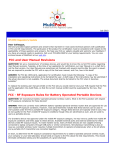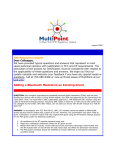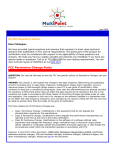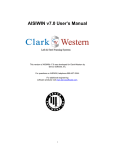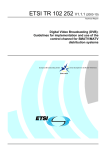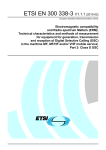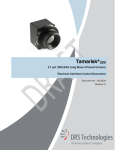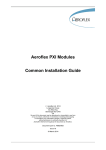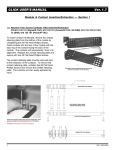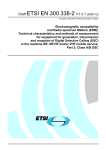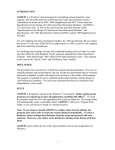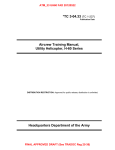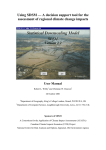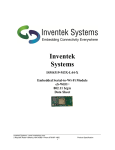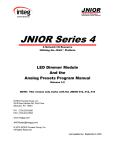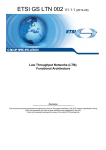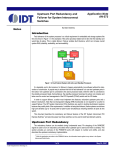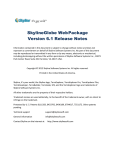Download MultiPoint - Rhein Tech Laboratories, Inc.
Transcript
March 2009 EMC Regulatory Update Dear Colleague, We have provided typical questions and answers that represent in most cases technical opinions with justification in FCC and CE requirements. The particulars of the product for certification must be considered with respect to the applicability of these questions and answers. We hope you find our update valuable and welcome your feedback if you have any special needs or questions. Call at 703-689-0368 or view archived issues of MultiPoint at our web site. FCC Part 15 and Receivers QUESTION: My employer manufactures Part 27 transceivers. Our compliance laboratory is insisting that the receiver part of our device must be tested to FCC Part 15. They explained that FCC Part 15 does apply because the device falls under FCC Part 27 (transceiver device) and the receiver section is subject to FCC rules and regulations. We are of the opinion that our laboratory is incorrect. We have reviewed the FCC Part 2 rules and searched the FCC's Knowledge Data Base (KDB) but cannot find any information that specifies the applicability of FCC Part 15 applies. FCC Part 2.1033 states what 'is' needed but not what "is not" needed. Can you shed some light into this issue on our behalf? ANSWER: While a transmitter can be a licensed device, the receiver is not. Receivers are FCC Part 15 devices, not licensed devices, even though they may work with or fit in a licensed device. The digital portion of a transmitter, whose digital circuitry function is only used to make the transmitter section function as intended, is not a FCC Part 15 device (see Part 15.3(k)). Part 15 states receivers are authorized based on their use, etc. As an example, a Part 15 receiver used in a licensed transceiver is always verified, whereas stand-alone receivers for the same type transmitter would Certification or Declaration of Conformity (DoC). If the receiver operates below 960 MHz, then FCC Part 15B Verification is appropriate for the receiver portion whereas scanning receivers are certified devices. The digital portion of the device would require FCC Part 15B as well (assuming it has a clock and microprocessor). See FCC Part 15.101 for Equipment Authorization of unintentional radiators. In summary, one must look at a device and divide it into all applicable sections. The transmitter section falls under FCC Part 27, if the receiver section falls between 30-960 MHz, then FCC Part 15 for the receiver section is applicable. If the device also contains digital device circuitry (or personal computer peripheral interface, etc.), then FCC Part 15 B also applies. The definition of receivers under FCC Part 15 does not distinguish between being unlicensed and licensed device. To know how and when Part 15 does apply in transceiver devices, the labeling of licensed or unlicensed devices under FCC Part 15.19 should be considered, FCC Part 15.19 (a)(1) states the following: (a) In addition to the requirements in part 2 of this chapter, a device subject to certification, or verification shall be labelled as follows: (1) Receivers associated with the operation of a licensed radio service, e.g., FM broadcast under part 73 of this chapter, land mobile operation under part 90, etc., shall bear the following statement in a conspicuous location on the device: "This device complies with part 15 of the FCC Rules. Operation is subject to the condition that this device does not cause harmful interference." R&TTE Questions QUESTION: Is it permissible, within the scope of the R&TTE Directive Annex II, for a manufacturer to apply only certain parts within a given harmonized standard(s) if the manufacturer can provide justification for doing so without the aid of an official opinion from a Notified Body (NB) or must a harmonized standard be applied in its entirely in order for a manufacturer to apply Annex II (Self- Declaration)? As an example, a harmonized standard provides test suites for both receiving and transmitting apparatus. The equipment under test and assessment is intended only for transmission and does not incorporate reception circuitry. For such a case, can the manufacturer apply the test suites that are relevant only to transmitters supplemented with an exemption statement on the DoC without the requirement to engage an opinion from a Notified Body? If a manufacturer and his authorized representative are not established within the EU community, can the manufacturer or his authorized representative sign the DoC or does the Directive require a person established within the EU Community (such as the importer) to sign the DoC. ANSWER: For your first question, we would say that in general it is OK to only apply the applicable parts of the standard. For example, most radio standards do contain a transmitter section and a receiver section. If the device is a transmitter only, then it is permitted to perform the transmitter tests only and to be confident that you have fully applied that standard to your device. You would not need a Notified Body to confirm that the receiver section is not required, for most devices. It would be considered fully applying the standard, for a transmitter. There are situations where you must be careful. For example, within the transmitter section there may be tests, which appear to apply to certain types of equipment, but are in fact mandatory. For example, EN 300 328 requests that a Medium Access Protocol exists. You could not say "not applicable because my device does not have a Medium Access Protocol" because it is a requirement of the standard. You could not exclude certain mandatory transmitter or receiver tests just because your device (transmitter or receiver) does not support them. Similarly, there is a UWB standard EN 302 500 where a receive capability is mandatory to fully comply with the standard. If a device were a transmitter only, and attempting to comply with EN 302 500, then it would not be possible to dismiss the receiver requirements without the assistance of a Notified Body because the standard specifically states that a receiver is required in the device. In this case, you could not exclude the receiver operation and claim to have fully met the standard. Regarding your second question, it is not essential for the importer or person within the EU Community to sign the DoC. The person who is responsible for the compliance of the device should sign the DoC. Most typically, this is the manufacturer (whether they are within the EU Community or outside it). However, anyone importing a device into the EU Community should consider their actions and check the validity of the DoC. If an importer wishes to import a device but no DoC exists, then the importer should take responsibility for compliance and would therefore sign the DoC. The Directive states the following, "the manufacturer or the person responsible for placing the apparatus on the market provides information for the user on the intended use of the apparatus, together with the declaration of conformity to the essential requirements." It further states, "the manufacturer or his authorized representative established within the Community...ensures and declares that the products concerned satisfy the requirements of this Directive that apply to them. The manufacturer or his authorized representative established within the Community must affix the CE marking to each product and draw up a written declaration of conformity." It also states, "the manufacturer must establish the technical documentation...and he or his authorized representative established within the Community must keep it for a period ending at least 10 years after the last product has been manufactured at the disposal of the relevant national authorities of any Member State for inspection purposes." It also further states, "where neither the manufacturer nor his authorized representative is established within the Community, the obligation to keep the technical documentation available is the responsibility of the person who places the product on the Community market." So, if the manufacturer is outside of the EU Community, then the person responsible for placing the device on the market must have access to the compliance documentation, in case it is needed. FCC Rules for "Developer Kit" QUESTION: We are a manufacturer of wireless products and have recently developed a product that is a "developer kit." This product is not intended for consumer use but rather for companies who want to test the product feasibility this technology and/or for educational purposes. The device has a serial and USB port available to control the transceiver, an integral antenna, and a regular SMA (SubMiniature version A) connect port. The regular SMA connector port is provided so that developers may directly connect the unit to a power meter or spectrum analyzer to measure the RF performance and RF power etc. The SMA connector port is made available by the removal of a resistor. My questions are as follows: 1. 2. 3. Since the SMA port configuration is not intended for an antenna configuration, but rather for RF instrumentation connection -which the manual would state -would a reverse threaded or non-standard connector be required for the SMA port? Are there any issues with developers removing components to change the integral antenna configuration to an SMA antenna configuration port? If there are instructions in the manual of how the end-user can modify the device, would the instructions suffice, or would the product have to be configured using hardware jumpers that allow the integral antenna or SMA port? ANSWER: In response to your question the scenario described does not appear to comply with FCC Part 15.203. Furthermore, if the preceding FCC Part 15.203 issue is addressed, and compliance for different configurations are addressed in your final application filing with the FCC, such end-user modification may not conflict with FCC Part 2.907, FCC Part 2.908 and FCC Part 2.931. You should also consider the following general remarks below: 1. 2. 3. 4. 5. Some transmitter circuit boards can be certified for "evaluation" or "demonstration" purposes, as long as it is not intended to be used as a module to be evaluated within a host device such as a laptop computer. Marketing of the device is not intended for the general public. Certification of this transmitter circuit board requires appropriate grant conditions and user instructions to limit marketing and use of the device and the user manual must agree with the above. The device must comply with FCC Part 15.203 and must not provide user instructions for use and evaluation with unauthorized antennas. Transmitter boards used for evaluation in host devices must be modular approved and comply with the modular approval requirements including shielding. An FCC Part 15 intentional-radiator product marketed without an antenna cannot have an FCC identifier, because FCC Part 15.204(b) states that an approved "transmission system" must always be marketed as a complete system. In other words, an FCC certification for any FCC Part 15 intentional radiator is valid only when a transmitter is marketed INCLUDING one or more approved antennas. For marketing as a component, please see at least FCC Part 2.803, and FCC Part 15.101, available by clicking on the links. In general, devices sold to a second party for manufacture or fabrication into a device that is subsequently sold (or leased) to a user does not require equipment authorization. What this means is that, in general a component may be sold to a second party for further fabrication without having to demonstrate compliance with FCC rules, but rather the end product that is sold to a vendor or user is subject to FCC rules. An "evaluation kit" grant covers a transmitter component as installed on a specific for-evaluation- purposes "motherboard" with a specific antenna, and which is considered to operate in mobile RF exposure conditions. The FCC identifier applies only for the component marketed and used in that specific board-mounted and specificantenna configuration. Use of the component itself in any other product requires separate FCC equipment authorization Photos Required by FCC for Intentional Radiators QUESTION: Our firm has designed an FCC Part 15 intentional radiator. Can you kindly confirm if internal photographs are required to show the top and bottom of each board in a device (we are NOT referring to the modular approval process in this case) or only the top and bottom view of the RF boards and other boards relating to the transmitter section? To our knowledge, the FCC has historically required for unintentional radiators that the internal photograph (for unintentional radiators) views show the top and bottom of all boards. Please confirm the current FCC's position on this policy. ANSWER: FCC Part 15 Equipment authorization for certification (intentional or unintentional) lists all items required for certifying a radiator under FCC Part 2.1033. The rules under the aforementioned section requires a sufficient number of photographs to clearly show the exterior appearance, the construction, the component placement on the chassis, and the chassis assembly. The FCC issued policy regarding interior and exterior photographs is as follows: • • • • • • Focused Not too dark No glare spots Component placement and circuit board traces clearly visible Photo of label and label placement Legible drawing of label and label placement acceptable Further clarification, if it is necessary to show component placement on the rear of individual boards then top and bottom view is necessary. The FCC's objective of the photographs is to document in compliance folder that the device has not changed. To also ensure that basic frequency determining and stabilizing circuitry (including clock or data rates), frequency multiplication stages, basic modulator circuit or maximum power or field strength ratings shall have not changed. You are required to show detail only for these boards and component placements and bottom views are only necessary if components are mounted on the bottom. For other (non-RF Boards) only photographs illustrating there position and placement in the chassis assembly is necessary. INTERNATIONAL UPDATE EU: NEW CENELEC STANDARDS RELEASED THIS MONTH This is a shortened list of the CENELEC standards published during the past month: • • • • • • • • • • EN 61169-38:2009 (3/2/2009) Radio-frequency connectors -- Part 38: Sectional specification - Radio frequency coaxial connectors model, slide-in (rack and panel applications) - Characteristic impedance 50 Ù (type TMA) - 50 Ù applications EN 60950-1:2006/A11:2009 (3/6/2009) Information technology equipment - Safety -- Part 1: General requirements EN 61558-1:2005/A1:2009 (3/12/2009) Safety of power transformers, power supplies, reactors and similar products -- Part 1: General requirements and tests EN 62369-1:2009 (3/13/2009) Evaluation of human exposure to electromagnetic fields from short range devices (SRDs) in various applications over the frequency range 0 GHz to 300 GHz -- Part 1: Fields produced by devices used for electronic article surveillance, radio frequency identification and similar systems EN 60974-8:2009 (3/18/2009) Arc welding equipment -- Part 8: Gas consoles for welding and plasma cutting systems EN 61557-9:2009 (3/18/2009) Electrical safety in low voltage distribution systems up to 1 000 V a.c. and 1 500 V d.c. - Equipment for testing, measuring or monitoring of protective measures -- Part 9: Equipment for insulation fault location in IT systems EN 61557-11:2009 (3/18/2009) Electrical safety in low voltage distribution systems up to 1 000 V a.c. and 1 500 V d.c. - Equipment for testing, measuring or monitoring of protective measures -- Part 11: Effectiveness of residual current monitors (RCMs) type A and type B in TT, TN and IT systems EN 55015:2006/A2:2009 (3/25/2009) Limits and methods of measurement of radio disturbance characteristics of electrical lighting and similar equipment EN 55016-2-1:2009 (3/25/2009) Specification for radio disturbance and immunity measuring apparatus and methods -- Part 2-1: Methods of measurement of disturbances and immunity - Conducted disturbance measurements EN 60079-10-1:2009 (3/26/2009) Explosive atmospheres -- Part 10-1: Classification of areas - Explosive gas atmospheres See CENELEC for additional information. EU: NEW IEC STANDARDS RECENTLY RELEASED This is a shortened list of the new IEC standards published during the past month: • • • • • • • • • IEC/PAS 61169-18 (3/5/2009) Radio- frequency connectors - Part 18: Sectional specification - Radio frequency coaxial connectors of type SSMA IEC/PAS 61169-19 (3/5/2009) Radio- frequency connectors - Part 19: Sectional specification for SSMB series R.F. coaxial connectors IEC/PAS 61169-35 (3/5/2009) Radio- frequency connectors - Part 35: Sectional specification - Radio frequency coaxial connectors of type 2,92 CISPR 12 (3/10/2009) Vehicles, boats and internal combustion engines - Radio disturbance characteristics Limits and methods of measurement for the protection of off-board receivers IEC 62003 (3/10/2009) Nuclear power plants - Instrumentation and control important to safety Requirements for electromagnetic compatibility testing ISO/IEC 24729-4 (3/11/2009) Information technology -- Radio frequency identification for item management -- Implementation guidelines -- Part 4: Tag data security ISO/IEC CASCO-CONF-2 (3/20/2009) Conformity assessment - Laboratories and inspection bodies IEC 60943 (3/24/2009) Guidance concerning the permissible temperature rise for parts of electrical equipment, in particular for terminals IEC 60601-2-50 (3/24/2009) Medical electrical equipment - Part 2-50: Particular requirements for the basic safety and essential performance of infant phototherapy equipment See IEC for additional information. EU: NEW ETSI STANDARDS RELEASED THIS MONTH This is a shortened list of the new ETSI standards published during the past month: • • • • • ETSI EN 302 544-1 V1.1.1 (February 2009) Broadband Data Transmission Systems operating in the 2 500 MHz to 2 690 MHz frequency band; Part 1: TDD Base Stations; Harmonized EN covering the essential requirements of article 3.2 of the R&TTE Directive ETSI TR 102 644-2 V1.1.1 (March 2009) Electromagnetic compatibility and Radio spectrum Matters (ERM); RFID Plugtests to investigate the interoperability of tags manufactured by different vendors; Part 2: Test plan and preliminary tests ETSI EG 202 116 V1.2.2 (March 2009) Human Factors (HF); Guidelines for ICT products and services; "Design for All" ETSI EN 300 440-1 V1.5.1 (March 2009) Electromagnetic compatibility and Radio spectrum Matters (ERM); Short range devices; Radio equipment to be used in the 1 GHz to 40 GHz frequency range; Part 1: Technical characteristics and test methods ETSI EN 300 440-2 V1.3.1 (March 2009) Electromagnetic compatibility and Radio spectrum Matters (ERM); Short range devices; Radio equipment to be used in the 1 GHz to 40 GHz frequency range; Part 2: Harmonized EN covering essential requirements of article 3.2 of the R&TTE Directive See new ETSI website for additional information. FCC: NEW RULES FOR WIRELESS MEDICAL DEVICES On March 17, 2009, the FCC adopted a Report and Order (FCC: 09-23) for advanced wireless medical radiocommunication devices used for human diagnostic and therapeutic purposes. The newly adopted rules fall under Part 95 and allocate additional spectrum at 401-406 MHz. These rules allow for a variety of devices that are either implanted or body-worn, and that operate either with "listen- before-talk" (LBT) technologies or at reduced power and low duty cycle. FCC: PROPOSAL TO PART 95 In addition to the Part 95 rules as stated above, on March 20, 2009, the FCC released ET Docket No. 09-36 proposing to allocate spectrum and adopt service and technical rules for the utilization of new implanted medical devices that would greatly expand the use of functional electric stimulation to restore sensation, mobility and function to paralyzed limbs and organs. These implanted neuromuscular microstimulators would function as wireless broadband medical micro-power networks (MMNs) within a patient. By eliminating the wires now used to interconnect multiple implanted neuromuscular microstimulators and the external power source for the implants, MMNs would greatly reduce the risk of infection and increase patient mobility and system reliability. The FCC is reviewing the feasibility of allowing up to 20 megahertz of spectrum in the 413-457 MHz band to be used under the Medical Device Radiocommunication Service (MedRadio Service) in FCC Part 95. The FCC seeks comment on the allocation of four specific segments for this purpose: 413-419 MHz, 426-432 MHz, 438-444 MHz, and 451457 MHz. Additionally, the FCC is seeking comment on the prospective service and technical rules that would govern MMN operations, such as transmitter power, emission bandwidth, duty cycle, contention protocols, and other operating specifications which generally comport with the framework of the existing MedRadio Service. CANADA: RELEASE OF RSS-220 On March 27, 2009, Industry Canada published Radio Standards Specification 220, Issue 1: Devices Using Ultra-Wideband (UWB) Technology. This standard establishes provisions for short-range devices using ultra-wideband (UWB) technology such as vehicular radar devices; communication (communication, measurement, location sensing, and tracking) devices; and radar imaging (ground penetrating radar (GPR), in-wall radar imaging, through-wall radar imaging, medical radar imaging, and radar surveillance) devices. RSS-220 is in force as of March 28, 2009 and there is no transition period. CONTACT RHEIN TECH FOR YOUR INTERNATIONAL REGULATORY APPROVALS Rhein Tech Laboratories' worldwide homologation services offer the best strategy for gaining product approval in a large number of target countries. In addition, we reduce the number of emissions, immunity, and product safety tests required by defining the minimum subset of regulatory standards at the onset, thus reducing the time and cost to enter multiple target countries. We offer research and approvals in over 50 countries. ABOUT US RTL has provided EMC compliance engineering & testing services since 1988 and has a superior reputation with both the Federal Communications Commission and others in the industry. RTL provides testing services to meet the emissions, immunity, and safety requirements of the European EMC Directive and the EU R&TTE Directive, all FCC rules and regulations, VCCI (Japan), ACMA (Australia), and other international standards. A special thank you to those who have recommended and contributed articles for our newsletter. Please continue to forward new and interesting material to our attention: [email protected]. We respect the privacy of our customers and colleagues. If you would like to cancel your MultiPoint updates, please follow the instructions at the end of this email. The information in the MultiPoint update is subject to change without notice. Learn More email: [email protected] phone: 703-689-0368 web: http://www.rheintech.com Last revised: March 30, 2009 Rhein Tech Laboratories, Inc. | 360 Herndon Pkwy, #1400 | Herndon | VA | 20170






